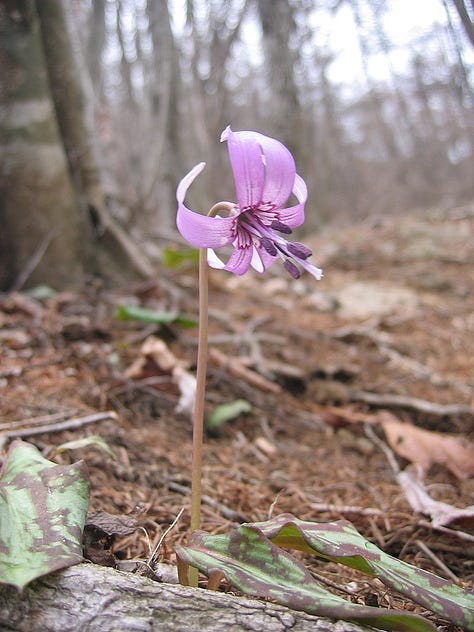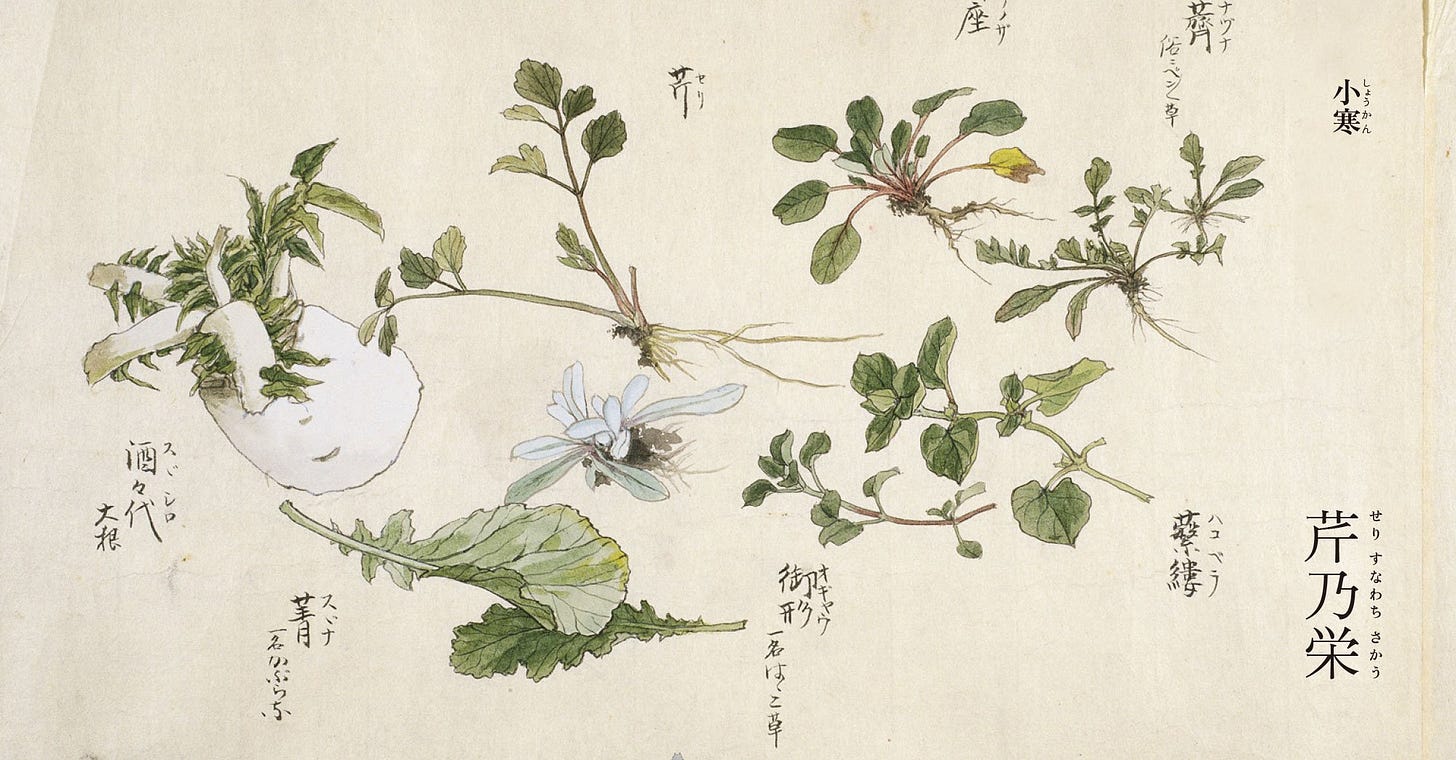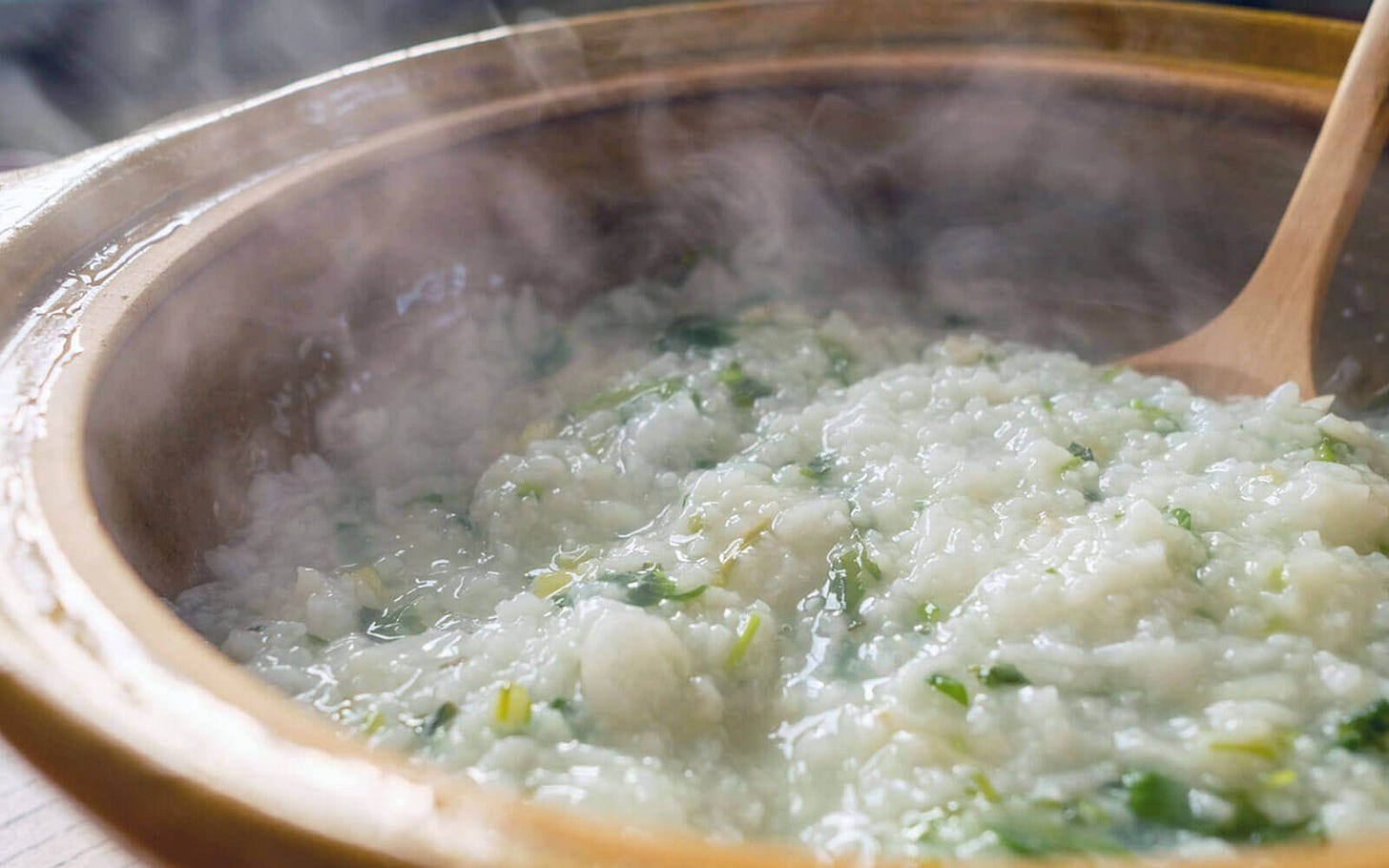January 6 - 10
芹乃栄
せりすなわちさかう
Seri sunawachi sakau
”Water celery flourishes”
In nature, all things have their time to thrive. And there’s plenty of beauty to be found in the splendor of the humble. Growing vigorously in cold swamps during the winter is no small feat, but its a yearly tradition for seri, one of Japan’s Seven Healthful Herbs.
Before we begin: many of you will have seen the news about the earthquake that struck Japan’s Ishikawa prefecture on New Years Day. The recovery and rescue efforts are ongoing, but one simple way you can help is by donating to Second Harvest. They provide on the ground support following disasters in the form of food. Food security can be an underlooked issue when most of the news and images focuses on destruction, but everyone needs to eat, and a good, warm meal can do a whole lot in a hard time.
A quote that is often reassuring to me in times when the news feels dark comes courtesy of Fred Rogers, who was an active humanitarian in addition to hosting his show Mister Rogers’ Neighborhood: “Look for the helpers. You will always find people who are helping.”
Of course, where you can, it’s even better to join the helpers when you do find them. Another quote—this one first heard at a volunteer group I worked with in similarly earthquake-struck Fukushima—reminds me there’s value in even the smallest of efforts: 出来る人が、出来るときに、出来ることを、出来るだけ (Dekiru hito ga, dekiru toki ni, dekiru koto wo, dekiru dake), or “People who can, in the time they can, doing the best they can at whatever they can.”1 It can be easy to get discouraged thinking you can’t do “enough,” but a lot of people doing a little is better than no one doing anything.

This does take us nicely back to seri and its place in the Japanese diet and food culture. Known in English by a variety of names—water dropwort, Japanese parsley, Indian pennywort, and the one we’ve gone with, water celery—seri is a perennial herb that likes to grow alongside ponds and swamps. It’s fully grown by spring, continuing to produce new growth all the way until early autumn, but here in the middle of winter it thrives and begins to rapidly grow fresh, young leaves.
It’s long been appreciated as an easily foraged2 and healthy plant, and eventually became part of the winter food tradition of Nanakusa-gayu (七草がゆ), a rice porridge3 made with seven different spring-growing plants and eaten on the seventh day of the new year. Alongside seri, the remaining six are4:
nazuna (薺) - Shepherd’s purse
hahakogusa (母子草) - Cudweed
hakobera (繫縷) - Chickweed
hotokenoza (仏の座) - Nipplewort
suzuna (菘) - Turnip leaves
suzushiro (蘿蔔) - Daikon radish leaves



The dish is eaten on one of the sekku, one of the auspicious seasonal days on which festivals and other ceremonies have long been held. We’ve mentioned them in a few different kō, and although many have fallen out of common practice, a handful are still celebrated to this day. For most of their history, they would have served as a time not only to look forward to and pass the year, but also to connect the community to one another and the country as a whole. These things create shared identity, and give an extra layer of purposeful observation to otherwise rote habits and isolated behaviors. Or offer a bit of poetic incentive to an undertaking that benefits people without needing to convince them of its necessity. In either case, there’s an importance in breaking up the year, in stopping alongside the road the refresh before continuing the journey.
Of course, for any tradition to be widely adopted and passed on, it has to have a good story to it. Some symbolism and, dare I say, a bit of magic that makes it feel worth doing even when you’re long past believing in such things.
Nanakusa-gayu is said to ward off sickness, and the vibrant green dotted among the white porridge is reminiscent of how the plants poke through the snow. On the night before the seventh day, the seven herbs, knife, cutting board, and rice scoop are all oriented in that year’s lucky direction5 then the herbs are chopped while singing a version of the below song6 seven times:
There's a practical side to the custom, as well. A lot of rich and heavy foods are eaten over the New Years holidays, and during the winter many people would rely on dried, smoked, or otherwise preserved food. The tradition of nanakusa-gayu provides a chance for fresh, green nutrition that revives and refreshes tired stomachs while teaching a community what herbs can be foraged in the middle of winter.
Winter could be a tense time for people who relied on crops. Waiting through the cold after celebrating the new year, farmers would hope for signs that the year to come would be a good one for their fields. The sekki that this kō (and the two after) are part of—Shōkan, or midwinter—contains two different days of omens. The fourth day of Shōkan is called Kanshirō (寒四郎), when the weather is said to influence that year’s wheat harvest. And should rain fall on the ninth day, it’s called Kanku-no-ame (寒九の雨) and considered to be a portent of a bumper crop.
During this time of limited daylight and looking for hints of healthy crops, it seems only natural that discovering a bit of vibrant green among the snow around your house would be a welcome sight. Perhaps that’s the reason that the kanji used in this kō for the seri’s growth is 栄—it doesn’t merely grow, or sprout, but instead flourishes (sakaeru, 栄える), undaunted by the ever-present cold.
One can’t be expected to survive solely on porridge, though, vitamin-rich and symbolic as it may be. Here’s some other seasonal options for eating and decorating during this kō:
● Seasonal seafood
shirako, 白子, milt● Seasonal vegetable
kabu, 蕪, turnip● Seasonal flower
katakuri, 片栗, dogtooth violet7



There’s a certain comfort in carrying out customs. Whatever else may be going on around it, the ritual of following a series of steps, saying a sequence of words, making a particular meal, it creates a spellbound moment that grounds us in time. And when the days seem to drag on after the holiday highs wear off, sometimes a bit of grounding is exactly what’s needed. That and a nice bellyful of fresh greens.
See you next kō~
[Images & info courtesy of kurashikata.com, kurashi-no-hotorisya.jp, 543life.com, and Wikipedia except where otherwise noted]
This quote is originally attributed to Natsuki Okamoto, a swimsuit model and television personality who put her career on hold following the March 11th Tohoku disasters and dedicated as much time, money, and effort as she could towards recovery
That being said, in appearance it is very similar to the toxic water hemlock—as always, you should exercise full caution and care if wild foraging or consuming anything raw you find
Water celery isn’t found in the wild outside Asia, so outside that region its safest to assume anything in other countries is poisonous
Traditionally, anyway—exactly what herbs are used would vary from place to place depending on availability and local custom
The concept of a lucky direction ties into the zodiacs and the Chinese Daoist principles that Japan integrated into their own customs, which we touched on back in Kō 59 with the “Hour Of The Rat”
For 2024, the lucky direction is east-northeast, and it will come up again in February on the day called Setsubun, where special sushi rolls called ehōmaki (恵方巻, lit. “lucky direction rolls”) are eaten facing that year’s direction
The songs lyrics vary by region, but generally are about plucking the seven herbs before the birds return from the mainland for spring
The roots of the katakuri were also used as a starch, but this has long been replaced by potato starch, which has a much higher yield per plant and is far easier to grow—however, the most popular brand on supermarket shelves is still called “Katakuri-ko,” complete with a purple label and violet plant motif







